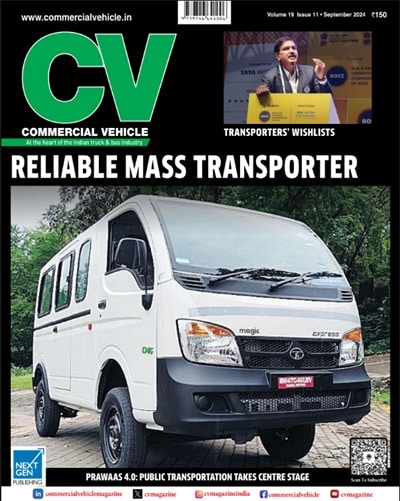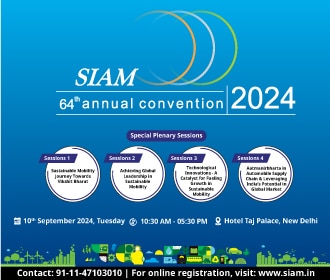 Hubner sees a substantial opportunity for articulated (vestibule) buses in India.
Hubner sees a substantial opportunity for articulated (vestibule) buses in India.
At the Auto Expo 2014, Tata Motors displayed an articulated bus. It was called the Starbus Urban 9/18. Built by Marcopolo, the articulated (vestibule) bus had 3-axles and measured 18 m in length. Powering it was a 280 hp, 6.7-litre ISBe six-cylinder BS4 diesel engine located at the front. The bus specifications claimed that it had a capacity to ferry 45 people and 48 standees. A prototype, according to Makarand Shahane, Director, Hubner Interface Systems India Pvt. Ltd., the articulated bus employed a Hubner articulation system. Stating that Tata Motors has shown interest, Shahane opined, “an articulated bus nearly doubles the amount of carrying capacity when compared to a bus that measures 12 m in length.” Most modern low-floor city buses in India measure 12 m in length, and have a capacity to seat between 32 to 40 people.
While the bi-articulated Volvo B12M of Curitiba with the body built by Neobus is considered to be one of the longest vestibule buses running in the world, measuring 28 m in length, the demand for articulated buses in India is also expected to grow. It is currently at a nascent stage. Claimed to be effective in reducing traffic congestion in many cities of the world, most vestibule buses find use as part of the Bus Rapid Transport (BRT) systems. Most are supported by the articulation systems made by Hubner. Kassel-based Hubner GmbH and Co. KG was established in 1936, and specialises in the manufacture of gangway systems, articulation systems, folding bellows, window systems, entrance systems, PUR-moulded foam parts, plastic injection moulded parts and rubber products under the bus business vertical. Claimed to be a EUR 350 million company by Makarand, Hubner operates under various industry verticals like airport, passenger cars, commercial vehicles, rail, medical technology, (Sensa) life quality, photonics and Terahertz.
Present in India since 2002, and offering articulation systems to the bus industry, the company, Hubner India, a wholly owned subsidiary of Hubner GmbH and Co. KG, begun trial production in late 2014 at its new plant in Bangalore. Stating that the plant capacity is enough to take care of the Indian market requirement, Shahane remarked, “We want to produce German quality (products), over numbers.” Pointing at an articulation system, Makarand stated, “We offer several models.” A result of the need to address diverse requirements like lower weight, higher load capacity and temperature resistance perhaps. Catering to low and high floor segments, Hubner, until 2013 supplied articulation systems by importing them from Germany. A facility was planned at Belgaum initially, but Bangalore was found to be more suitable. Mentioning that the articulation system occupies 1.6 m of length of an 18 m long articulated bus, leaving the bus body builder to build the rest (16.4 m) of the bus body, Shahane claimed that his company has supplied 400 units in India till date. “Almost 99 per cent of the articulated buses went on to operate in the cities of Chennai, Hyderabad, Bangalore and Chandigarh,” he added. Most of these are high floor articulated buses built by Ashok Leyland, and fitted with Hübner articulation systems.
Also called as ‘sweeper buses’ according to Makarand, a good deal of the articulated buses were built by Ashok Leyland in the period between 2001 and 2007. Of the opinion that Tata and Ashok Leyland have intentions to make articulated buses, Shahane said, “We are here to support them.” Employing an articulation system that costs in the region of Rs. 18 to Rs. 20 lakh, articulated buses in India are expected to follow the success of Metro-rail and Mono-rail in a road-going form. Producing articulated systems at the Bangalore plant with the help of people trained in Europe, Shahane averred, that engineers from Germany come down to work with clients. “Support is needed for installation,” he said. Incurring close to 20 per cent less cost due to local manufacture, Huber is well aware of the unique requirements the Indian market may demand. The company is also aware that the Indian market could be a mix of push-articulated buses with the engine at the rear, and articulated buses with the engine at the front. Like the one that Tata Motors displayed at the Auto Expo 2014. “We believe that there is a substantial opportunity for articulated buses (in India),” stated Shahane.





























